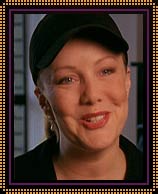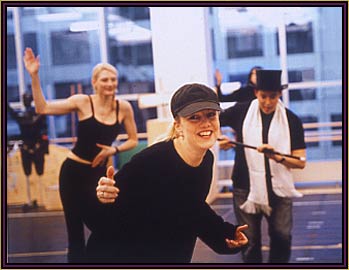 One of Broadway’s brightest lights in the new millennium, innovative choreographer Susan Stroman made a smashing entrance to the directing ranks, with the original dance drama “Contact” (which she co-created) and the revival of “The Music Man” both premiering to raves on the Great White Way in the spring of 2000. Receiving four Tony nods for directing and choreographing the two shows, she joined Michael John LaChuisa (who also garnered four nominations that year for the books and scores of “The Wild Party” and “Marie Christine”) as the first quadruple honorees since Elizabeth Swados in 1978. Exposed to show tunes by her piano-playing salesman father, Stroman acted in community theater in her hometown of Wilmington, Delaware but really got the bug when a touring version of “Seesaw” came to the Wilmington Playhouse with Tommy Tune in clogs leading a chorus line of girls festooned with balloons. Inspired by the combination of a “great love story” and lots of choreography, she moved to New York and toured in the original productions of Bob Fosse’s “Chicago” and the revue “Sugar Babies.”
One of Broadway’s brightest lights in the new millennium, innovative choreographer Susan Stroman made a smashing entrance to the directing ranks, with the original dance drama “Contact” (which she co-created) and the revival of “The Music Man” both premiering to raves on the Great White Way in the spring of 2000. Receiving four Tony nods for directing and choreographing the two shows, she joined Michael John LaChuisa (who also garnered four nominations that year for the books and scores of “The Wild Party” and “Marie Christine”) as the first quadruple honorees since Elizabeth Swados in 1978. Exposed to show tunes by her piano-playing salesman father, Stroman acted in community theater in her hometown of Wilmington, Delaware but really got the bug when a touring version of “Seesaw” came to the Wilmington Playhouse with Tommy Tune in clogs leading a chorus line of girls festooned with balloons. Inspired by the combination of a “great love story” and lots of choreography, she moved to New York and toured in the original productions of Bob Fosse’s “Chicago” and the revue “Sugar Babies.”

Stroman during rehearsals for the megahit "The Producers," which she directed.
Stroman’s first big break came when director Scott Ellis hired her to choreograph the Off-Broadway revival of Kander and Ebb’s “Flora, the Red Menace” (1987). Director Harold Prince saw her work and tapped her to provide the dances for his New York City Opera production of “Don Giovanni.” After reteaming with Ellis for both the New York City Opera’s “A Little Night Music” (1990), telecast as part of “Live at Lincoln Center” (PBS), and the Kander and Ebb Off-Broadway review “And the World Goes ‘Round” (1991), which she also co-conceived, she collaborated with director (and future husband) Mike Ockrent on “Crazy for You” (1992), winning her first Tony for Choreography. Stroman received an Emmy nomination for choreographing LIZA MINNELLI LIVE! FROM RADIO CITY MUSIC HALL (PBS, 1992), co-conceived and choreographed the Emmy-nominated SONDHEIM: A CELEBRATION AT CARNEGIE HALL (PBS, 1993), and provided the Tony-winning choreography for the triumphant revival of “Show Boat” (1994), directed by Prince. She also created the dances for the Broadway revival of William Inge’s “Picnic” that year.
Stroman experienced back-to-back Broadway failures with “Big” (1996), the misfired adaptation of the popular Penny Marshall feature starring Tom Hanks, and Kander and Ebb’s “Steel Pier” (1997), reuniting with Ockrent on the former and Scott Ellis on the latter. However, Lincoln Center’s artistic director Andre Bishop, responding positively to the dancing and poetry of “Steel Pier,” told her if she had an idea for a show, he would help develop it. Stroman called John Weidman, who had written the book for “Big,” and the two began working on what would become the steamy, three-part dance play “Contact.” Meanwhile, she scored a major coup as choreographer of Trevor Nunn’s revival of “Oklahoma!” (1998) at London’s National Theatre. Receiving permission from the respective estates to break with tradition (as she would later do for “The Music Man”), she courageously replaced Agnes de Mille’s historic choreography at the close of Act I, stamping her own signature on the ballet by having the three principals (not their alternate fantasy selves) perform it. Michael Coveny of THE DAILY MAIL called her choreography “perhaps the biggest star of the night.”
Susan Stroman
- "Big"
- "Contact"
- "Crazy for You"
- "The Frogs"
- "The Music Man"
- "The Producers"
- "Show Boat"
- "Thou Shall Not"
- Matthew Broderick
- Mel Brooks
- Nathan Lane
- Cameron Mackintosh
- Trevor Nunn
- Harold Prince
- Stephen Sondheim
- Robin Wagner
“Contact” was a delight at Lincoln Center’s Mitzi Newhouse Theater when it opened in the fall of 1999, and it made a terrific transformation upstairs to the Broadway house in 2000 (where it was reclassified as a musical). The larger Vivian Beaumont Theater freed the dancers emotionally as well as physically, and made a much more suitable home for the marriage of Stroman’s exuberant and witty choreography with Weidman’s equally funny and touching words. If the choreography was an afterthought when “The Music Man” first opened in 1957, her version was a tour de force of dance. Resisting the pressure to put a “big star” in the role of consummate con man Harold Hill, she went with relative no-name Craig Bierko (in his Broadway debut) who proved more than up to the task. Yet, in the midst of bringing two shows to Broadway, Ockrent, with whom she had also collaborated annually on Madison Square Garden’s “A Christmas Carol,” lost his battle to leukemia, and the death of her husband stole much of the sweetness from Stroman’s greatest hour as a professional. She also provided choreography for Nicholas Hytner’s feature dance drama “Center Stage” (2000), including a climactic number that A. O. Scott in THE NEW YORK TIMES called “sexy and infectious.”
Stepping in for her late husband, Stroman assumed the reins of the stage musical adaptation of THE PRODUCERS, based on the Mel Brooks comedy. From its opening in Chicago, the musical earned sterling reviews and had audiences guffawing in the aisles. Stroman’s fluid direction and signature choreographic touches merely enhanced the hilarity inherent in the script and songs, and the show proved to be a triumph on Broadway, earning a record 12 Tony Awards, including those for direction and choreography.
Source: Excerpted from Baseline. BaselineStudioSystems — A Hollywood Media Corp. Company.
Photo credits: Photofest and Paul Kolnik

